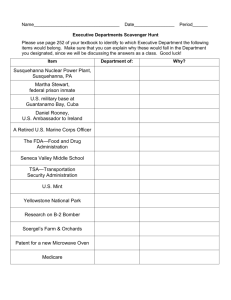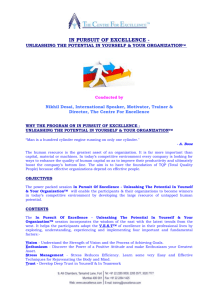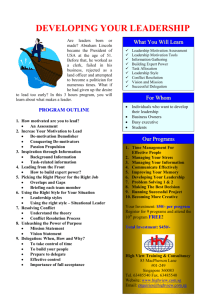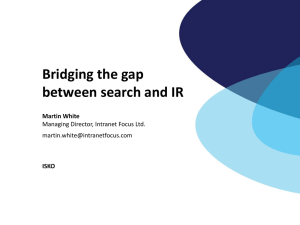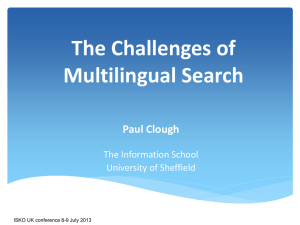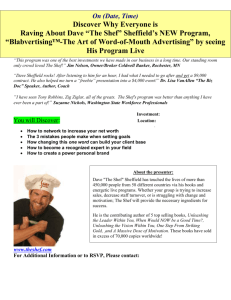SoergelSlidesISKO
advertisement
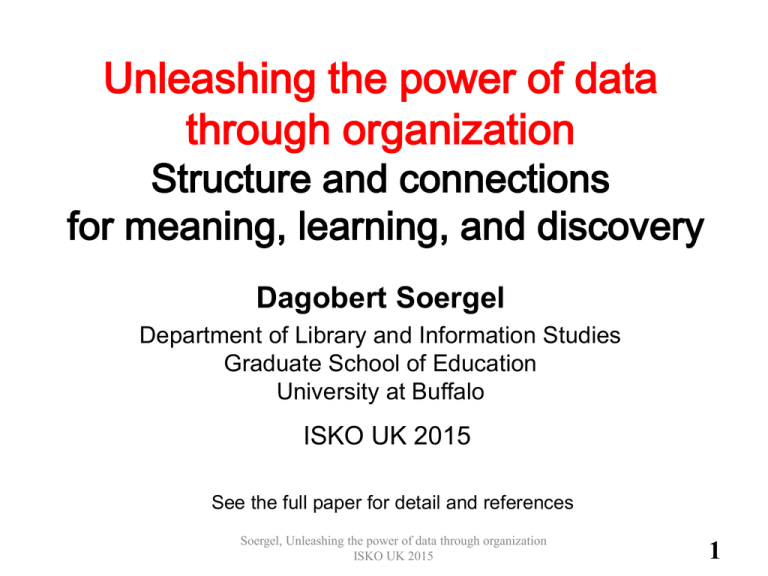
Unleashing the power of data through organization Structure and connections for meaning, learning, and discovery Dagobert Soergel Department of Library and Information Studies Graduate School of Education University at Buffalo ISKO UK 2015 See the full paper for detail and references Soergel, Unleashing the power of data through organization ISKO UK 2015 1 The Future of Knowledge Organization Knowledge organization is needed everywhere Create the future of KO Think BIG. Think answers not pointers. Focus on substantive data Many areas, tasks, and functions that could profit from KO principles Engage with Ontologies, AI, data modeling Soergel, Unleashing the power of data through organization ISKO UK 2015 2 Areas, tasks, and functions 1 Knowledge bases for question-answering and cognitive systems 2 Knowledge base for information extraction from text or multimedia 3 Linked data 4 Big data and data analytics. Data interoperability and reuse 5 Interoperability of operational information systems. Electronic health records (EHR) as an example 6 Information systems in the enterprise 7 Influence diagrams (causal maps), dynamic system models, process diagrams, concept maps, and other node-link diagrams 8 Knowledge organization for understanding and learning 9 Knowledge transfer between domains Soergel, Unleashing the power of data through organization ISKO UK 2015 3 Unification • across applications • across types of data (example: organization database treated like classification) • across disciplines, supports knowledge transfer from one discipline domain to another • across languages (precise definitions) • across cultures, across organizations (organizational cultures) • across worldviews Soergel, Unleashing the power of data through organization ISKO UK 2015 4 Part 2 The application of Knowledge Organization Soergel, Unleashing the power of data through organization ISKO UK 2015 5 2.1 Knowledge bases for question-answering and cognitive computing Soergel, Unleashing the power of data through organization ISKO UK 2015 6 Knowledge base Some KOS used Common sense knowledge CYC Ontology, including entity types, relationship types, and entity values IBM Watson An extensible inventory of relationship types CYC Custom KB for applications Google Knowledge Graph Huge database of varied kind of data (Starr 2014) DBpedia Large database of statements extracted from Wikipedia GDELT Event reports schema.org for entity types and relationship types DBpedia Ontology (E-R schema) Authority lists for individual entity values (instances), each identified by a URI. CAMEO Coding Scheme for events Own list of 300 themes, World Bank Taxonomy themes 2,300 emotions and themes (from 24 sentiment analysis packages) US government geonames standards Soergel, Unleashing the power of data through organization ISKO UK 2015 7 2.2 Knowledge base for information extraction from text or multimedia Often only text is considered, but information can be extracted from graphs and video (for example, identifying people by face recognition and relationships between people from analyzing scenes). In the following text+ Soergel, Unleashing the power of data through organization ISKO UK 2015 8 Information extraction • Entity extraction (Named-entity recognition) Locating references to entities in text+, associate with a unique identifier. • Information extraction Formally represent the propositions the text makes about these entities. Information extraction both uses and feeds knowledge bases for question answering. Soergel, Unleashing the power of data through organization ISKO UK 2015 9 KOS for information extraction Information extraction needs much knowledge, which must be properly organized into KOS • Linguistic knowledge: morphological, part-of-speech, and lexical (meaning). Lexicalized phrases. • Large KOS listing entity values and their (multiple) names (persons, organizations, places, concepts/subjects, ...) • Knowledge supporting word sense disambiguation (WSD). Both linguistic knowledge and world knowledge. Soergel, Unleashing the power of data through organization ISKO UK 2015 10 2.3 Linked data • Entity-relationship data model • Data from independent data sets can linked • Key implementation component of the Semantic Web • Enormous opportunity for KO. – Deploying KOS data on the Web and have them more widely used. – Linked data require properly structured and often very large KOS. Soergel, Unleashing the power of data through organization ISKO UK 2015 11 Linked data • The more pervasive standardization with respect to entity types relationship types entity values the more successful linked data searching will be • This is a problem of knowledge organization Soergel, Unleashing the power of data through organization ISKO UK 2015 12 Drug <hasName> Text DBDrug <hasName> Text Drug <hasGenericVersion> Drug DBDrug <hasGenericName> Text DBDrug <hasCASRegistryNumber> URI Drug <hasActiveIngredient> ChemicalSubstance Drug <hasClinicalPharmacologyDescr> Text DBDrug <hasAbsorptionDescr> Text DBDrug <hasBioTransformDescr> Text DBDrug <hasPharmacolDescr> Text DBDrug <hasProteinBindRate> Pct Drug <hasIndicationDescr> Text DBDrug <hasIndicationDescr> Text DBDrug <hasPossibleDiseaseTarget> Disease Drug <hasContraIndicationDescription> Text DBDrug <hasContraIndicationInsert> Document Drug <administeredVia> RouteOfAdministration DBDrug <hasDosageForm> DosageForm Soergel, Unleashing the power of data through organization ISKO UK 2015 13 2.4 Big data and data analytics. Data interoperability and reuse Soergel, Unleashing the power of data through organization ISKO UK 2015 14 Example 1. Merging like datasets • Research question: Factors affecting school success • Need large sample, so merge data sets with anonymized data on individual students and test scores from many US states (many European countries) • Problem: this works only if variables are defined the same way in all data sets – Factors such as socio-economic status of the student or home environment – Concepts and skills covered in the tests. • This is a knowledge organization problem Soergel, Unleashing the power of data through organization ISKO UK 2015 15 Example 2. Linking datasets • Research question: relationships between per capita income, how people feel about the economy, and birth rate Unit of analysis: Locality • The variables needed are in three different data sets: 1 per-capita income by locality 2 Twitter messages (analyze for sentiment) 3 Birth rate by locality The data sets need to be linked so that for each locality we have values for the three variables • Problem: The ability to link these data sets depends on the linking variable, locality, being defined the same way and identifiable (a problem with Twitter) Soergel, Unleashing the power of data through organization ISKO UK 2015 16 2.5 Interoperability of operational information systems Electronic health records (EHR) as an example • Interoperability of EHR data is an obvious must, but far from solved. • Needs KOS for – – – – – race/ethnicity, age, sex bodily or mental functions or conditions diseases medical procedures drugs • Worked on heavily, mainly by people in biomedical informatics / biomedical ontologies. • Given here as one example of the importance of KO for operational systems. Soergel, Unleashing the power of data through organization ISKO UK 2015 17 2.6 Information systems in the enterprise Soergel, Unleashing the power of data through organization ISKO UK 2015 18 Example 1 • Problem: Many organizations do not know in a central place what data they have • Solution: – Develop an enterprise-wide entity-relationship conceptual data schema (an enterprise ontology, an enterprise data model, the modern version of a data dictionary), using ideas from Web standards. – Use this to organize an inventory or registry of all data systems in the organization and the specific pieces of data in each. Soergel, Unleashing the power of data through organization ISKO UK 2015 19 Example 2 Unified authority database for Organizations considered for the World Bank Group (WBG) Soergel, Unleashing the power of data through organization ISKO UK 2015 20 Soergel, Unleashing the power of data through organization ISKO UK 2015 21 21 Example 2 cont. • The enterprise-wide Organization Authority Database should be structured exactly like a hierarchical thesaurus: Just like concepts, the organizations form a hierarchy, and they have multiple names Soergel, Unleashing the power of data through organization ISKO UK 2015 22 2.7 Node-link diagrams • Causal maps (influence diagrams) • Dynamic system models • Process diagrams • Concept maps • Other Soergel, Unleashing the power of data through organization ISKO UK 2015 23 Influences on overweight and obesity Soergel, Unleashing the power of data through organization ISKO UK 2015 24 shiftN causal map for obesity Soergel, Unleashing the power of data through organization ISKO UK 2015 25 Segment the large and detailed shiftN causal map for obesity Soergel, Unleashing the power of data through organization ISKO UK 2015 26 Soergel, Unleashing the power of data through organization ISKO UK 2015 27 Soergel, Unleashing the power of data through organization ISKO UK 2015 28 KO issues • Arranging variables in a meaningful order • Mapping variables from one model to another Coming up later • Merging node-link diagrams • Linking node-link diagrams Soergel, Unleashing the power of data through organization ISKO UK 2015 29 shiftN causal map variables. Top level with example detail (arranged by DS) Individual Environment Engine Energy balance Conscious control of accumulation Effort to acquire energy Strength of lock-in to accumulate energy Physiology Degree of primary appetite control by brain Genetic and/or epigenetic predisposition Food consumption Food production Force of dietary habits Tendency to graze Demand for convenience Food exposure Food variety Societal pressure to consume Demand for health Pressure to improve access to food offerings Cost of ingredients Individual physical activity Level of transport activity Individual psychology Food literacy Stress Physical activity environment Dominance of motorised transport Opportunity for unmotorised transport Social psychology Exposure to food advertising Peer pressure Soergel, Unleashing the power of data through organization ISKO UK 2015 30 Some (approximate) matches and non-matches between 4 lists of variables Soergel, Unleashing the power of data through organization ISKO UK 2015 31 shiftN Kaplan Energy balance Energy balance Nanotechnology Downey' list Engine Energy intake Energy expenditure Conscious control of accumulation lack of self-control Effort to acquire energy Response to food cues Physiology Appetite control by brain Genetic & epigenetic predisposition Food consumption genetics epigenetic factors Food and bev. intake overeating Force of dietary habits Food production Food & bev. industry Malnutrition (conv. foods) high fruct. corn syrup Agricultural production agricultural policies Food deserts food deserts Cost of ingredients Indiv. physical activity Physical activity Exercise & physical activity Lack of exercise Soergel, Unleashing the power of data through organization ISKO UK 2015 Low physical activity 32 More uses of node-link diagrams In biology and in industrial engineering • diagrams of sequential and interrelated processes that lead to some outcome or state In biology • diagrams of signaling pathways, • diagrams of metabolic networks, • diagrams of gene regulatory networks Soergel, Unleashing the power of data through organization ISKO UK 2015 33 Concept maps • Used as thesaurus displays since the 1950s • Resurfaced forcefully in education • If you know of earlier uses, let me know Soergel, Unleashing the power of data through organization ISKO UK 2015 34 2.8 Knowledge organization for understanding and learning Soergel, Unleashing the power of data through organization ISKO UK 2015 35 Foundational Model of Anatomy: Entity types Soergel, Unleashing the power of data through organization ISKO UK 2015 36 Foundational Model of Anatomy: Relationship types Soergel, Unleashing the power of data through organization ISKO UK 2015 37 Hypothesis Students who are taught anatomy using the Foundational Model of Anatomy have a better grasp of the structure of the body. Soergel, Unleashing the power of data through organization ISKO UK 2015 38 Concept map about birds Soergel, Unleashing the power of data through organization ISKO UK 2015 39 Concept map hypotheses The bird concept map will allow learners to form a better internal representation of a bird as a system. Constructing concept maps will help learners to develop a better understanding (a better structured mental model) of the topic. Soergel, Unleashing the power of data through organization ISKO UK 2015 40 Britannica Elementary: Menu for Animal Kingdom Thoughtless arrangement, devoid of any meaning Soergel, Unleashing the power of data through organization ISKO UK 2015 42 Animal Kingdom: Meaningful arrangement based on modern science Animals without a spine (invertebrates) Snails, octopus, mussels (mollusks) Bugs (insects), spiders, crabs (arthropods) Animals with a spine (vertebrates) Fish Frogs, toads, salamanders (amphibians) Lizards&snakes, crocodiles, dinosaurs, birds Lizards&snakes, crocodiles, dinosaurs (reptiles) Birds Elephants, whales, cows, dogs, bats, mice, monkeys, apes, humans (mammals) Note: Could simplify, add pictures Soergel, Unleashing the power of data through organization ISKO UK 2015 43 Vertebrates cladogram Soergel, Unleashing the power of data through organization ISKO UK 2015 44 Meaningful arrangement hypothesis Young students who use the animal home page with the meaningful arrangement will over time absorb the sequence and perceive a progression. When much later in biology the structure of the animal kingdom and the evolution of animals are discussed, these students will understand more quickly. Soergel, Unleashing the power of data through organization ISKO UK 2015 45 2.9 Knowledge transfer between domains Soergel, Unleashing the power of data through organization ISKO UK 2015 46 Management styles and educational styles compared Style of social interaction Management style Educational style Autocratic, authoritarian, directive Autocratic, authoritarian, directive (coercive), topdown Direct instruction, teachercentered Teacher as formal authority, expert Military style Military style Military style Paternalistic Paternalistic Authoritative (visionary) Authoritative (visionary) Persuasive Persuasive Coaching Coaching Individual inner discipline, motivation, agreement with norms Teacher as facilitator Montessori Soergel, Unleashing the power of data through organization ISKO UK 2015 47 Figure 17. Management styles and educational styles compared Style of social interaction Management style Educational style Participatory, democratic Participatory (democratic), consultative Democratic and Free Schools Collaborative, teamwork Collaborative, teamwork Cooperative Learning Teacher as facilitator, delegator Self-directed groups Holacracy, self-management in groups Laissez-faire, free-wheeling Laissez-faire Chaotic Chaotic People try their own thing Open Schools (and Classrooms) (Summerhill) Inquiry-based learning, student-centered (related to constructivism) Teacher as facilitator, delegator Soergel, Unleashing the power of data through organization ISKO UK 2015 48 Part 3 General observations on knowledge organization and its role Soergel, Unleashing the power of data through organization ISKO UK 2015 49 3.1 Better data modeling • Entity-relationship modeling is fundamental Kudos to Peter Chen (1976) and precursors • Three past blunders 1 Attributes as elements in entity-relationship modeling 2 Calling relationships properties, as is done in RDF 3 Using only binary (two-way) relationships Soergel, Unleashing the power of data through organization ISKO UK 2015 50 Part 4 Conclusions Soergel, Unleashing the power of data through organization ISKO UK 2015 51 Conclusions 1 • Many applications of KOS. • Consider both – requirements for machine processing, specifically inference, and – requirements for human processing, specifically meaningful arrangements that assists in making sense Soergel, Unleashing the power of data through organization ISKO UK 2015 52 Conclusions 2 • Many opportunities for people with good training in KO to improve KOS now used • Prepare students for that, specifically – Students should have a basic understanding of logic, formal ontology principles, inference, and complex queries – Foster the ability to discern meaningful structures and then convey structure and meaning through good document design. – Foster the ability to work with researchers on defining variables, determining data collection methods, and curating, and sharing data , all to improve interoperability and reusability. Soergel, Unleashing the power of data through organization ISKO UK 2015 53 Conclusions 3 • We need more communication between the following largely separated communities: – Knowledge Organization – Semantics in linguistics and terminology – Knowledge representation in artificial intelligence – Ontology – Data Modeling – Semantic Web Soergel, Unleashing the power of data through organization ISKO UK 2015 54 The Future of Knowledge Organization Knowledge organization is needed everywhere Create the future of KO Think BIG. Think answers not pointers. Focus on substantive data Many areas, tasks, and functions that could profit from KO principles Engage with Ontologies, AI, data modeling Soergel, Unleashing the power of data through organization ISKO UK 2015 55 Dagobert Soergel dsoergel@buffalo.edu www.dsoergel.com Soergel, Unleashing the power of data through organization ISKO UK 2015 56 57 58
